Multi-Criteria Approach for Prioritizing and Managing Public Investment in Urban Spaces. A Case Study in the Triple Frontier
Abstract
1. Introduction
2. Materials and Methods
2.1. Case Study
2.2. Process
2.2.1. Inspection of Urban Components
2.2.2. Urban Street Condition Index (USCI)
2.2.3. Value Function
3. Results
Urban Street Condition Index (USCI) for the Triple Border Region
4. Discussion
5. Conclusions
Author Contributions
Funding
Institutional Review Board Statement
Informed Consent Statement
Data Availability Statement
Acknowledgments
Conflicts of Interest
References
- Younis, F. Significance of Infrastructure Investment for Economic Growth. MPRA Paper No. 72659, Posted 26 Jul 2016 16:58 UTC. Available online: https://mpra.ub.uni-muenchen.de/72659/ (accessed on 17 March 2021).
- Broniewicz, E.; Ogrodnik, K. Multi-criteria analysis of transport infrastructure projects. Transp. Res. Part D Transp. Environ. 2020, 83, 102351. [Google Scholar] [CrossRef]
- Wallbaum, H.; Krank, S.; Teloh, R. Prioritizing sustainability criteria in urban planning processes: Methodology application. J. Urban Plan. Dev. 2011, 137, 20–28. [Google Scholar] [CrossRef]
- Wey, W.-M. Constructing urban dynamic transportation planning strategies for improving quality of life and urban sustainability under emerging growth management principles. Sustain. Cities Soc. 2019, 44, 275–290. [Google Scholar] [CrossRef]
- Medina, M.G.; García, M. Ángeles, H. Real innovation in urban planning? Assessing the institutional capacity in the frame of the integrated sustainable urban development programmes. Eur. Plan. Stud. 2019, 28, 1139–1160. [Google Scholar] [CrossRef]
- Carrese, S.; Cuneo, V.; Nigro, M.; Pizzuti, R.; Ardito, C.F.; Marseglia, G. Optimization of downstream fuel logistics based on road infrastructure conditions and exposure to accident events. Transp. Policy 2019. [Google Scholar] [CrossRef]
- Marseglia, G.; Medaglia, C.M.; Ortega, F.A.; Mesa, J.A. Optimal alignments for designing urban transport systems: Application to Seville. Sustainability 2019, 11, 5058. [Google Scholar] [CrossRef]
- Cigu, E.; Agheorghiesei, D.T.; (Vatamanu), A.F.G.G.; Toader, E. Transport infrastructure development, public performance and long-run economic growth: A case study for the EU-28 countries. Sustainability 2018, 11, 67. [Google Scholar] [CrossRef]
- Välilä, T. Infrastructure and growth: A survey of macro-econometric research. Struct. Chang. Econ. Dyn. 2020, 53, 39–49. [Google Scholar] [CrossRef]
- Adinarayana, B.; Mir, M.S. Development of pedestrian safety index models for safety of pedestrian flow at un-signalized junctions on urban roads under mixed traffic conditions using MLR. Innov. Infrastruct. Solut. 2021, 6, 1–9. [Google Scholar] [CrossRef]
- Wang, J.; Yang, C.; Zhao, J. Conditions for setting exclusive pedestrian phases at two-phase signalized intersections considering pedestrian-vehicle interaction. J. Adv. Transp. 2021, 2021, 1–14. [Google Scholar] [CrossRef]
- Beura, S.K.; Chellapilla, H.; Panda, M.; Bhuyan, P.K. Bicycle Comfort Level Rating (BCLR) model for urban street segments in mid-sized cities of India. J. Transp. Health 2021, 20, 100971. [Google Scholar] [CrossRef]
- Arellana, J.; Saltarín, M.; Larrañaga, A.M.; González, V.I.; Henao, C.A. Developing an urban bikeability index for different types of cyclists as a tool to prioritise bicycle infrastructure investments. Transp. Res. Part A Policy Pr. 2020, 139, 310–334. [Google Scholar] [CrossRef]
- Labdaoui, K.; Mazouz, S.; Acidi, A.; Cools, M.; Moeinaddini, M.; Teller, J. Utilizing thermal comfort and walking facilities to propose a comfort walkability index (CWI) at the neighbourhood level. Build. Environ. 2021, 193, 107627. [Google Scholar] [CrossRef]
- Peeters, A.; Shashua-Bar, L.; Meir, S.; Shmulevich, R.R.; Caspi, Y.; Weyl, M.; Motzafi-Haller, W.; Angel, N. A decision support tool for calculating effective shading in urban streets. Urban Clim. 2020, 34, 100672. [Google Scholar] [CrossRef]
- Ahmad, S.N.; Harianto, T.; Samang, L.; Hustim, M. Level Vulnerability Damage of Pavement Using Pavement Condition Index Method; EDP Sciences: Makassar, Indonesia, 2018; Volume 181, p. 11003. [Google Scholar]
- Shruti, S.; Singh, P.K.; Ohri, A. Evaluating the environmental sustainability of smart cities in india: The design and application of the Indian smart city environmental sustainability index. Sustainability 2020, 13, 327. [Google Scholar] [CrossRef]
- Pinatt, J.M.; Chicati, M.L.; Ildefonso, J.S.; Filetti, C.R.G.D. Evaluation of pavement condition index by different methods: Case study of Maringá, Brazil. Transp. Res. Interdiscip. Perspect. 2020, 4, 100100. [Google Scholar] [CrossRef]
- Boomen, M.V.D.; Spaan, M.T.J.; Schoenmaker, R.; Wolfert, A.R.M. Untangling decision tree and real options analyses: A public infrastructure case study dealing with political decisions, structural integrity and price uncertainty. Constr. Manag. Econ. 2018, 37, 24–43. [Google Scholar] [CrossRef]
- Gibson, J.; Rioja, F. The welfare effects of infrastructure investment in a heterogeneous agents economy. BE J. Macroecon. 2019, 20. [Google Scholar] [CrossRef]
- Fogel, R. La región de la triple frontera: Territorios de integración y desintegración. Rev. Socio. Porto Alegre 2008, 20, 270–290. [Google Scholar] [CrossRef][Green Version]
- Wu, Z.; Chen, R.; Meadows, M.E.; Sengupta, D.; Xu, D. Changing urban green spaces in Shanghai: Trends, drivers and policy implications. Land Use Policy 2019, 87, 104080. [Google Scholar] [CrossRef]
- Marull, J.; Farré, M.; Boix, R.; Palacio, A.B.; Ruiz-Forés, N. Modelling urban networks sustainable progress. Land Use Policy 2019, 85, 73–91. [Google Scholar] [CrossRef]
- Guo, S.H.; Yang, G.G.; Pei, T.; Ma, T.; Song, C.; Shu, H.; Du, Y.Y.; Zhou, C.H. Analysis of factors affecting urban park service area in Beijing: Perspectives from multi-source geographic data. Landscape Urban Plan. 2019, 181, 103–117. [Google Scholar] [CrossRef]
- Canitez, F. Transferring sustainable urban mobility policies: An institutional perspective. Transp. Policy 2020, 90, 1–12. [Google Scholar] [CrossRef]
- Morillas, J.M.B.; Gozalo, G.R.; González, D.M.; Moraga, P.A.; Vílchez-Gómez, R. Noise Pollution and Urban Planning. Curr. Pollut. Rep. 2018, 4, 208–219. [Google Scholar] [CrossRef]
- San José, J.; García, A. Planteamiento MIVES para la evaluación caso de la EHE. Dialnet 2008, 91, 28–36. [Google Scholar]
- Saaty, T. AHP: The Analytic Hierarchy Process; Mc Graw-Hill: New York, NY, USA, 1980. [Google Scholar]
- National Association of City Transportation Officials (NACTO). Urban Street Design Guide; Island Press: New York, NY, USA, 2013. [Google Scholar]
- Associação Brasileira De Normas Técnicas. NBR 12255: Execução e Utilização de Passeios Públicos-Procedimento; Associação Brasileira De Normas Técnicas: Sâo Paulo, Brazil, 1991; pp. 1–6. [Google Scholar]
- Associação Brasileira De Normas Técnicas. NBR 16537: Acessibilidade—Sinalização Tátil no Piso-Diretrizes para Elaboração de Projetos e Instalação; Associação Brasileira De Normas Técnicas: Sâo Paulo, Brazil, 2016. [Google Scholar]
- Ley 962. Código de Edificación de la Ciudad de Buenos Aires, Argentina, Accesibilidad Física Para Personas Con Necesidades Especiales; Boletín Oficial Number 1197; Comisión para la Plena Participación e Inclusion de las Personas con Capacidad COPIDIS: Buenos Aires, Argentina, 2001. [Google Scholar]
- Osama, A.; Sayed, T. Evaluating the impact of connectivity, continuity, and topography of sidewalk network on pedestrian safety. Accid. Anal. Prev. 2017, 107, 117–125. [Google Scholar] [CrossRef]
- Kirschbaum, J.; Axelson, P.; Longmuir, P.; Mispagel, K.; Stein, J.; Yamada, D. Designing sidewalks and trails for access. Best practices design guide. Fed Highw. Admin 2001, II, 484. [Google Scholar]
- American Association of State Highway Transportation Officials (AASHTO). Guide for the Planning, Design, and Operation and Pedestrian Facilities; American Association of State Highway Transportation Officials: Washington, DC, USA, 2004; ISBN 1-56051-271-7. [Google Scholar]
- Federal Highway Administration (FHA). Distress Identification Manual for the Long-Term Pavement Performance Program; Publication No. FHWA-HRT-13-092, Revised May 2014; Federal Highway Administration (FHA): Georgetown, DC, USA, 2003.
- Hadiwardoyo, S.P.; Correia, A.G.; Pereira, P. Road deterioration analysis for the national roads of Indonesia. In Proceedings of the 14th International Conference on QIR (Quality in Research), Lombok, Indonesia, 11–12 August 2015; Volume 14. [Google Scholar]
- American Association of State Highway and Transportation Officials (AASHTO). Distress Identification Manual for the Long-Term Pavement Performance Program (DIM); American Association of State Highway and Transportation Officials (AASHTO): McLean, VA, USA, 2003. [Google Scholar]
- Instituto Nacional de Vías INVIAS. Manual Para la Inspección Visual de Pavimentos Flexibles. Estudio E Investigación Del Estado Actual de Las Obras de la Red Nacional de Carreteras; Ministerio de Transporte. Convenio Interadministrativo 0587-03: Bogotá, Colombia, 2006.
- Instituto Nacional De Tecnología, Normalización Y Metrología. PNA 4500110: Accesibilidad a la Personas Al Medio Físico. Criterios Y Requisitos Generales de Diseño Para un Entorno Edificado Accesible; INTN Publisher: Asunción, Paraguay, 2010. [Google Scholar]
- Ministerio De Desarrollo Económico. Manual Práctico de Diseño Universal: Basado en la Ley 962, Accesibilidad Física Para Todos: Caba, 1st ed.; Ciudad Autónoma de Buenos Aires: Gobierno de la Ciudad Autónoma de Buenos Aires; Comisión para la Plena Participación e Inclusión de las Personas con Discapacidad-COPIDIS: Buenos Aires, Argentina, 2015; ISBN 978-987-673-030-3. [Google Scholar]
- Associação Brasileira De Normas Técnicas. NBR 9050: Acessibilidade a Edificações, Mobiliário, Espaços E Equipamentos Urbanos; ABNT Publisher: Rio de Janeiro, Brazil, 2015; p. 162. [Google Scholar]
- Cal Y Mayor, R.; Cárdenas, J. Ingeniería de Tránsito. Fundamentos Y Aplicaciones, 9th ed.; Alfa Omega: Mexico City, Mexico, 2014. [Google Scholar]
- Marisamynathan, S.; Lakshmi, S. Method to determine pedestrian level of service for sidewalks in Indian context. Transp. Lett. 2018, 10, 294–301. [Google Scholar] [CrossRef]
- Banerjee, A.; Maurya, A.K.; Lämmel, G. Pedestrian flow characteristics and level of service on dissimilar facilities: A critical review. Collect. Dyn. 2018, 3, 1–52. [Google Scholar] [CrossRef]
- Conceicao, L.; Correia, G.; Tavares, J.P. The deployment of automated vehicles in urban transport systems: A methodology to design dedicated zones. Transp. Res. Procedia 2017, 27, 230–237. [Google Scholar] [CrossRef]
- Muthanna, M.S.A.; Lyachek, Y.T.; Musaeed, A.M.O.; Esmail, Y.A.H.; Adam, A.B.M. Smart system of a real-time pedestrian detection for smart city. In Proceedings of the 2020 IEEE Conference of Russian Young Researchers in Electrical and Electronic Engineering (EIConRus), Moscow/St. Petersburg, Russia, 27–30 January 2020; pp. 45–50. [Google Scholar]
- Cook, N.; Hughes, R. Shading Liveable Cities: Exploring the ecological, financial and regulatory dimensions of the urban tree canopy. In State of Australian Cities Conference 2015: Refereed Proceedings; Burton, P., Shearer, H., Eds.; State of Australian Cities Research Network: Wollongon, Australia, 2015; pp. 1–10. [Google Scholar]
- Associação Brasileira De Normas Técnicas. NBR 10151: Acústica-Medição E Avaliação de Níveis de Pressão Sonora Em Aeas Habitadas-Aplicação de Uso Geral; Associação Brasileira De Normas Técnicas: Sâo Paulo, Brazil, 2019. [Google Scholar]
- Legislatura de la Ciudad Autónoma de Buenos Aires, Argentina. Ley 1540: Control de la Contaminación ACústica-Prevención -Control–Corrección-Contaminación Acústica; Gobierno de la Ciudad de BA: Buenos Aires, Argentina, 2004.
- Amado, H.; Ferreira, S.; Tavares, J.P.; Ribeiro, P.; Freitas, E. Pedestrian–vehicle interaction at unsignalized crosswalks: A systematic review. Sustainability 2020, 12, 2805. [Google Scholar] [CrossRef]
- Fistola, R.; Gallo, M.; La Rocca, R.A.; Russo, F. The effectiveness of urban cycle lanes: From dyscrasias to potential solutions. Sustainability 2020, 12, 2321. [Google Scholar] [CrossRef]
- Noring, L. Public asset corporation: A new vehicle for urban regeneration and infrastructure finance. Cities 2019, 88, 125–135. [Google Scholar] [CrossRef]
- Torres, C.; Sobreira, L.; Castro-Neto, M.; Cunto, F.; Vecino-Ortiz, A.; Allen, K.; Hyder, A.; Bachani, A. Evaluation of pedestrian behavior on mid-block crosswalks: A case study in Fortaleza—Brazil. Front. Sustain. Cities 2020, 2. [Google Scholar] [CrossRef]
- Lima, J.P.; Machado, M.H. Walking accessibility for individuals with reduced mobility: A Brazilian case study. Case Stud. Transp. Policy 2019, 7, 269–279. [Google Scholar] [CrossRef]
- Asplund, D.; Pyddoke, R. Optimal fares and frequencies for bus services in a small city. Res. Transp. Econ. 2020, 80, 100796. [Google Scholar] [CrossRef]
- Highway Capacity Manual: 2000: Transportation Research Board: Books; Transportation Research Board Publisher: Washington, DC, USA, 2000; p. 1287. ISBN 0-309-06681-6.
- Saaty, T.L. Decision making—the analytic hierarchy and network processes (AHP/ANP). J. Syst. Sci. Syst. Eng. 2004, 13, 1–35. [Google Scholar] [CrossRef]
- Gómez López, D.; del Caño, A.; de la Cruz, M.P.; Josa, A. Metodología genérica para la evaluación de la sostenibilidad de sistemas constructivos. El método MIVES. In Sostenibilidad y Construcción (en Prensa); Asociación Científico-Técnica del Hormigón (ACHE): Madrid, Spain, 2012. [Google Scholar]

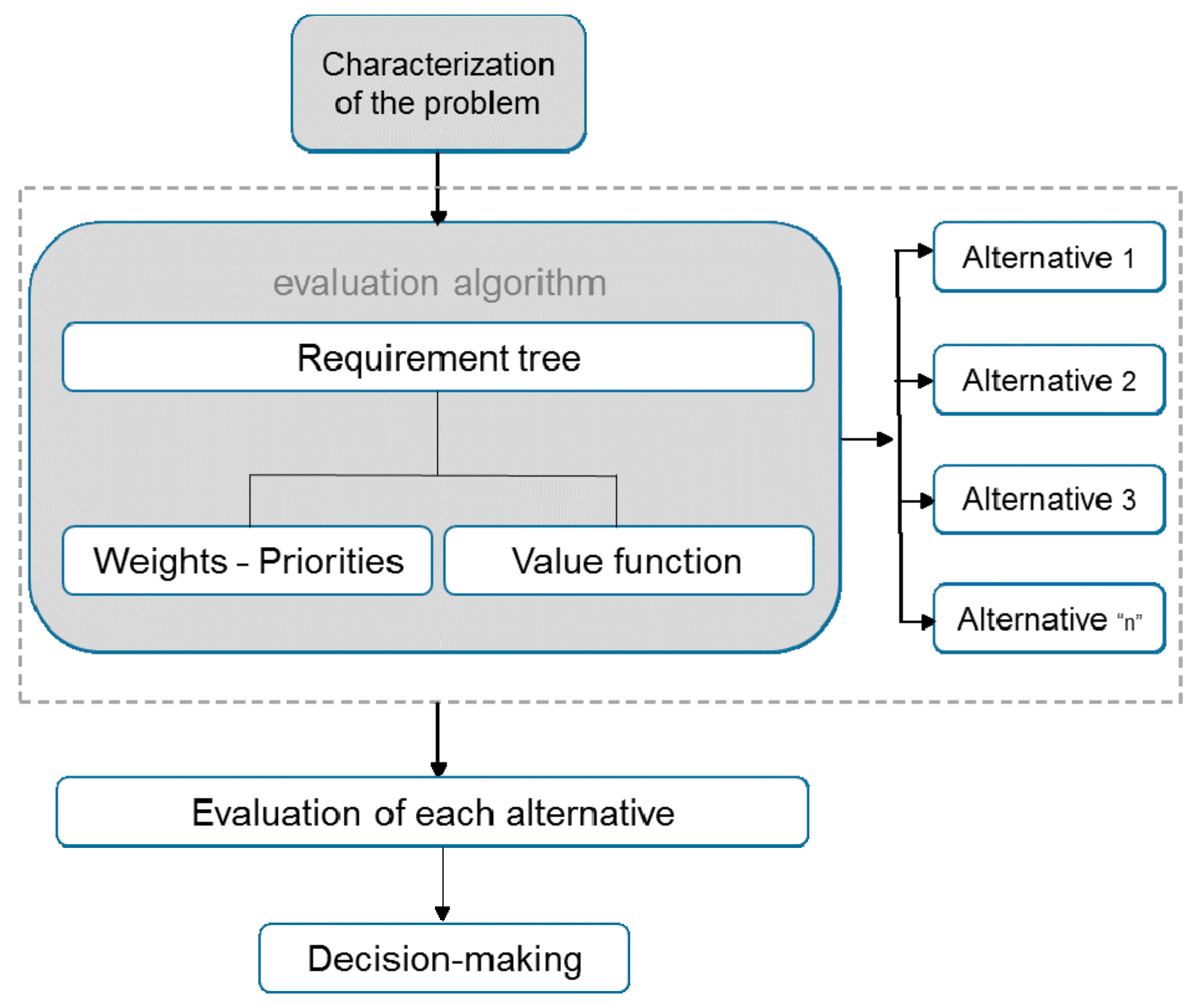
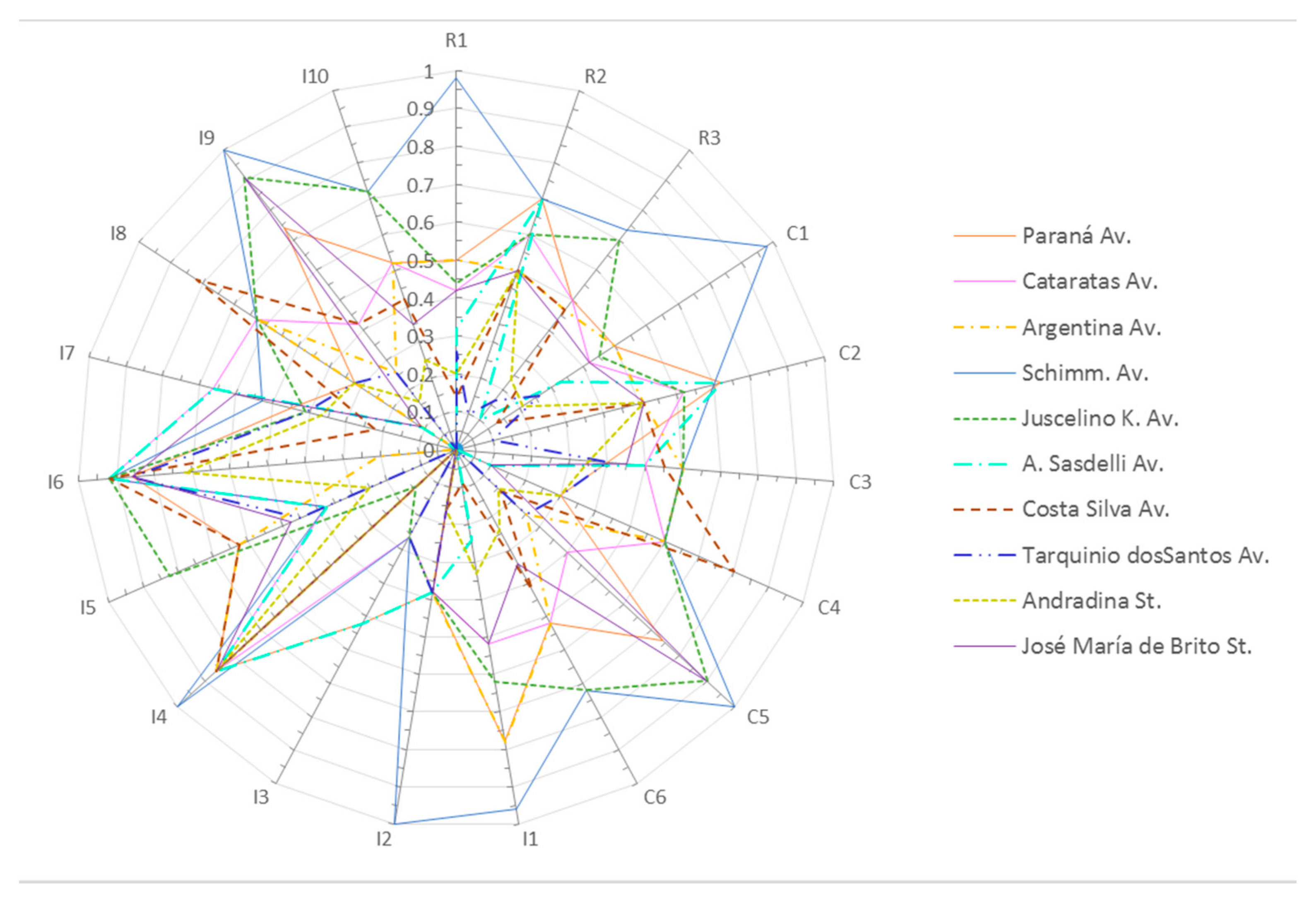
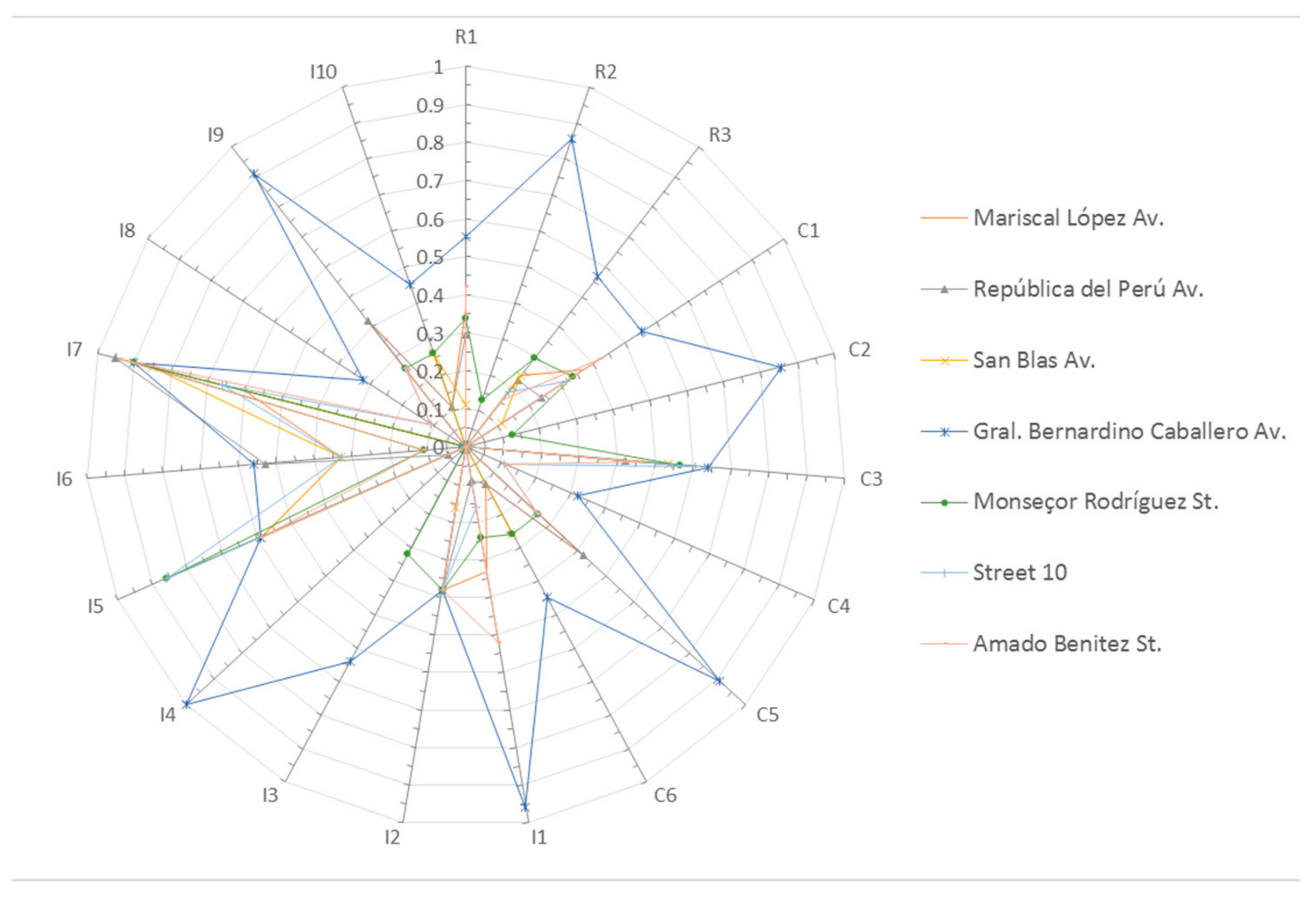
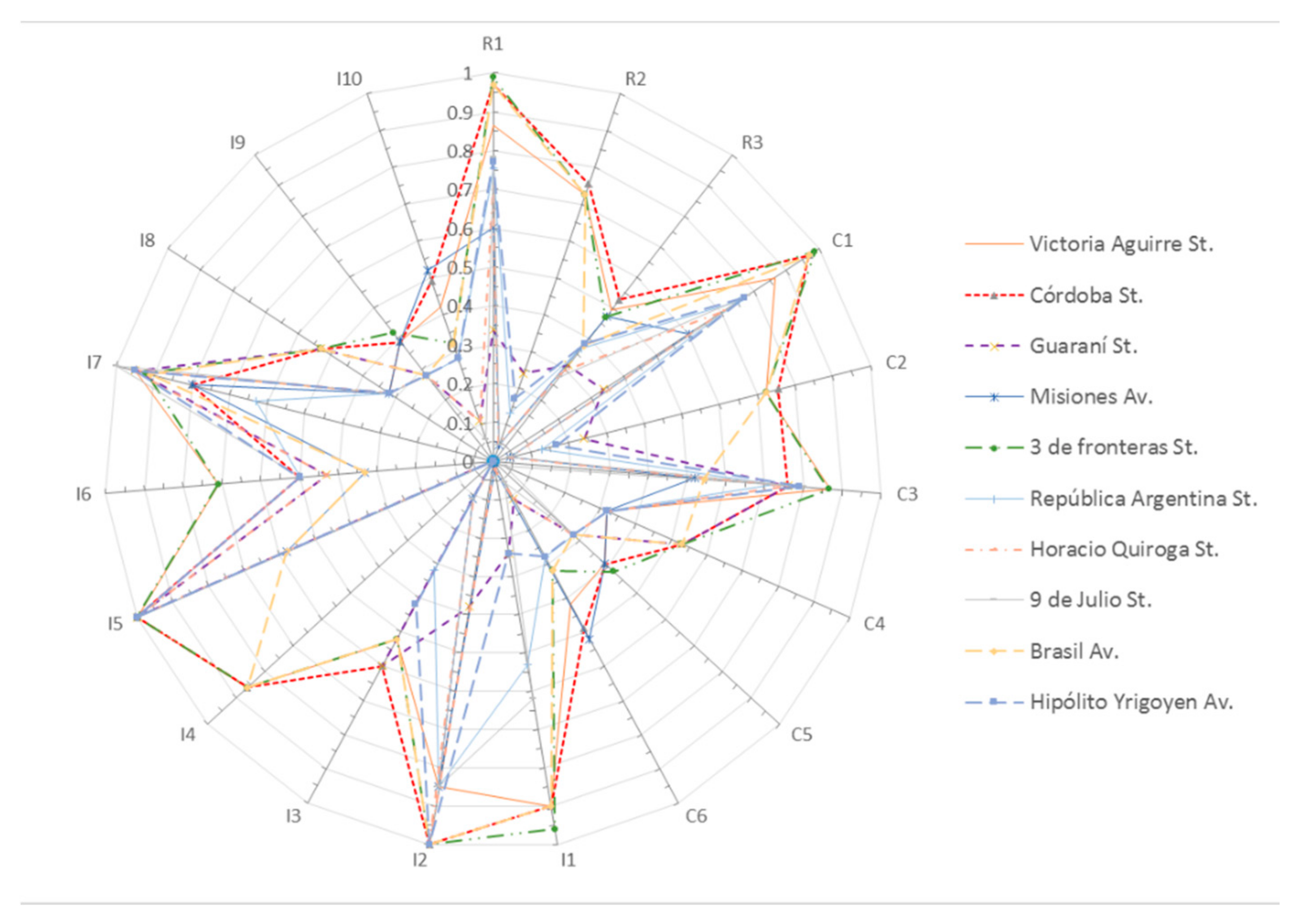
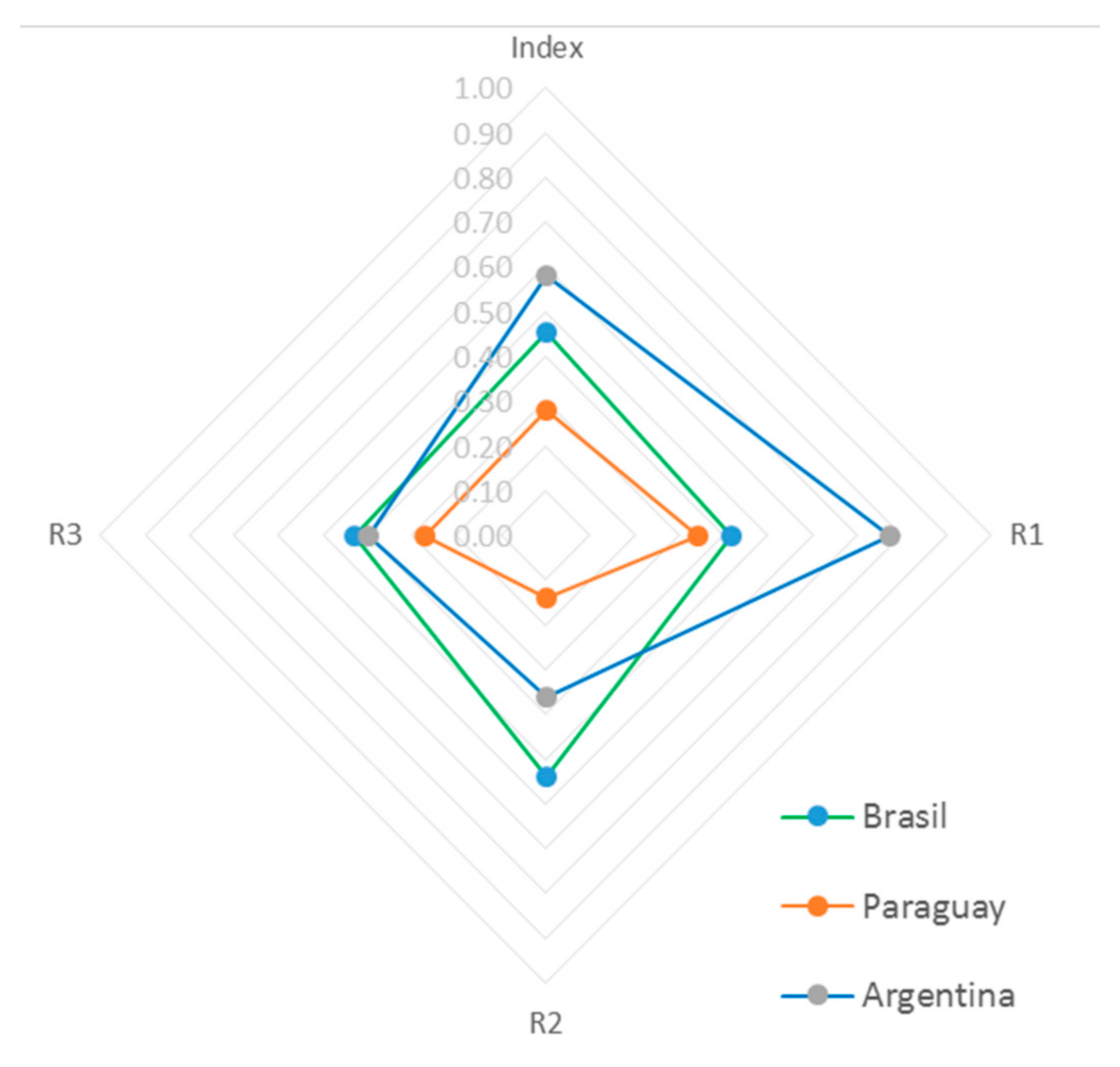
| Foz do Iguaçu | Ciudad del Este | Puerto Iguazú |
|---|---|---|
| Paraná Av. (1) | Mariscal López Av. (1) | Victoria Aguirre St. (1) |
| De las Cataratas Av. (2) | República de Perú Av. (2) | Córdoba St. (2) |
| República Argentina St. (3) | San Blas (3) | Guaraní St. (3) |
| Jorge Schimmelpfeng Av. (4) | Gral. Bernardino Caballero (4) | Misiones (4) |
| Juscelino Kubitscheck Av. (5) | Monseñor Rodríguez (5) | Tres Fronteras Av. (5) |
| Silvio Américo Sasdelli (6) | Calle 10 (6) | República Argentina Av. (6) |
| Costa e Silva (7) | Armando Benítez (7) | Horacio Quiroga (7) |
| Tarquínio Joslin dos Santos (8) | 9 de Julio Av. (8) | |
| Andradina Av. (9) | Brasil St. (9) | |
| José María de Brito Av. (10) | Victoria Aguirre St. (10) |
| Indicator | Parameter | Reference |
|---|---|---|
| I1-Sidewalk quality | Sidewalk deterioration | [29,30,31,32] |
| Sidewalk continuity | [33,34] | |
| Sidewalk illumination | [35] | |
| Deterioration of the asphalt surface | [36,37] | |
| I2-Asphalt surface quality | Service levels | [38,39] |
| I3-Adaptations in urban infrastructure of elderly and infirm persons | Adaptations of urban infrastructure | [40,41] |
| I4-Circulation areas | Presence of circulation areas | [42] |
| I5-Sidewalk service level | Service levels | [43,44] |
| I6-Mobility quality | Sidewalk density (Service levels) Mobility interferences Traffic lights for pedestrians Shading | [43,45] |
| [46] | ||
| [47] | ||
| [48] | ||
| I7-Noise pollution | Measurement in decibels | [49,50,51] |
| I8-Interferences | Presence of speed devices Light vehicle pedestrian interruptions Percentage of light vehicles | [43,52] |
| I9-Quality of the journey and safety | Bikeway Traffic lights Track lighting Respect for the cyclist | [53,54] |
| I10-Quality of infrastructure and signaling | Preferential transit route Existence of speed controls Quality of bus stop Frequency quality Signaling | [55,56] |
| Requirement | Criteria | Indicator | Unit |
|---|---|---|---|
| Urban infrastructure | Physical state of the element. | Sidewalk quality | Score 0–100 |
| Asphalt Surface quality | |||
| Accessibility | Compliance with regulations. | Adaptations in infrastructure for people of elderly and infirm persons | |
| Circulation areas | |||
| Mobility | Pedestrian | Mobility quality | |
| Noise pollution | Decibels | ||
| Light vehicle | Interferences | Score 0–100 | |
| Cyclist | Quality of the journey and safety | ||
| Public transportation. | Quality of infrastructure and signaling |
| Parameter | Degree of Compliance | Weighing |
|---|---|---|
| Sidewalk deterioration | A—Continuous and totally flat sidewalk. No deformations in 100% of the studied section. No presence of gaps or material wear. Surface with tactile signage for users with reduced visibility. Curbs in perfect condition and without deterioration. | 60 |
| B—Continuous and totally flat sidewalk. Without deformation up to 80% of the studied section. No gaps and little material wear. Absence of tactile signage for users with reduced visibility. Presence of wear on protection curbs. | 40 | |
| C—Discontinuous sidewalk with deformations in most of the section studied. Little presence of holes and visual deterioration of the pavement coating. It does not present risk to the user. Absence of tactile signage for users with reduced visibility. Possibility of rehabilitation of the sidewalk. | 20 | |
| D—Discontinuous sidewalk with deformations in most of the section studied. High presence of voids and high material wear. Start of material loss from the sidewalk. Absence of tactile signage for users with reduced visibility. | 10 | |
| E—Discontinuous sidewalk with deformations in most of the section studied. Detachment of pavement coating material. Presence of gaps and wear of the material with risk for the user. Absence of tactile signage for users with reduced visibility. Need for replacement of the sidewalk. | 0 | |
| Sidewalk continuity | i. Without interruptions | 20 |
| ii. 1 to 4 interruptions | 10 | |
| iii. 5 to 10 interruptions | 5 | |
| iv. more than 10 interruptions | 0 | |
| Sidewalk illumination | The studied section has sidewalk lighting | 20 |
| The section studied is without sidewalk lighting | 0 |
| Parameter | Degree of Compliance | Weighing |
|---|---|---|
| Asphalt Surface deterioration | A—Surface in perfect condition and without the presence of pathologies on the asphalt. Presence of rain collectors. Identification of signage on the runway. | 100 |
| B—Surface in perfect condition with initial presence of pathologies in the asphalt. Presence of rain collectors. No signaling on the runway. | 50 | |
| C—Surface with presence of pathologies without loss of material. Existence of crocodile skin and cracks greater than 5 mm. | 20 | |
| D—Asphalt surface deteriorated with loss of material. Visible asphalt layer groove. Lack of surface drainage elements. | 10 | |
| E—Deterioration of the asphalt surface greater than 80%. Loss of material, presence of rutting with risk for the user. User speed reduction due to surface pathologies. | 0 |
| Parameter | Degree of Compliance | Weighing |
|---|---|---|
| Circulation | The section has circulation areas for people with reduced capacities on the road; it considers accesses and circulations for wheelchairs without interference throughout the road. | 100 |
| The section has circulation areas for people with reduced capacities on the road; it considers accesses and circulations for wheelchairs in some parts of the studied section. | 50 | |
| The section does not have circulation areas for people with reduced capacities on the road; it does not consider accesses and circulations for wheelchairs in any part of the studied section. | 0 |
| Parameter | Degree of Compliance | Weighing |
|---|---|---|
| Urban infrastructure in accessibility | Accessibility adaptations to comply with regulations | 50 |
| Adequate sidewalk marking | 25 | |
| Integration of international symbols | 25 |
| Parameter | Degree of Compliance | Weighing |
|---|---|---|
| Sidewalk density | If It is service level A | 20 |
| Between service level B and C | 10 | |
| Between service level D and E | 5 | |
| If It is service level F | 0 | |
| Mobility interferences | The section studied does not present interferences. | 45 |
| Between 1 and 5 | 20 | |
| Between 6 and 10 | 10 | |
| more than 10 | 0 | |
| Pedestrian traffic lights | The section has a pedestrian traffic light | 10 |
| The section has not a pedestrian traffic light | 0 | |
| Shading | Presence of trees in the section: More than 200 | 25 |
| Presence of trees in the section between 100 and 200 | 10 | |
| Presence of trees in the section between 50 and 100 | 5 | |
| Presence of trees in the section between 0 and 50 | 0 |
| Service Level | Space (m2 per Pedestrian) | Flow Rate (Pedestrian/min/m) | Speed (m/s) |
|---|---|---|---|
| A | >5.60 | ≤16 | >1.30 |
| B | >3.70–5.60 | >16–23 | >1.27–1.30 |
| C | >2.20–3.70 | >23–33 | >1.22–1.27 |
| D | >1.40–2.20 | >33–49 | >1.14–1.22 |
| E | >0.75–1.40 | >49–75 | >0.75–1.14 |
| F | ≤0.75 | Variable | ≤0.75 |
| Parameter | Degree of Compliance | Weighing |
|---|---|---|
| Presence of speed devices | Yes | 25 |
| Not | 0 | |
| Light vehicle pedestrian interruptions | Without interruptions | 15 |
| Between 1 and 5 | 5 | |
| More than 5 | 0 | |
| Percentage of light vehicles | More than 50% | 10 |
| Less than 50% | 0 |
| Parameter | Degree of Compliance | Weighing |
|---|---|---|
| Bikeway | The section considers bike path | 50 |
| The section does not consider bike path | 0 | |
| Traffic lights | The section considers a traffic light for cyclists | 10 |
| The section does not consider a traffic light for cyclists | 0 | |
| Road Illumination | Illuminated road | 25 |
| Unlit road | 0 | |
| Respect for the cyclist | Yes | 15 |
| Not | 0 |
| Parameter | Degree of Compliance | Weighing |
|---|---|---|
| Preferential traffic lane | Yes | 30 |
| Not | 0 | |
| Devices speed control | Yes | 15 |
| Not | 0 | |
| Bus stop quality | Excellent | 25 |
| Good | 10 | |
| Regular | 5 | |
| Poor or not present | 0 | |
| Frequency quality (Minutes) | Between 5 and 10 | 25 |
| Between 11 and 20 | 10 | |
| Between 20 and 30 | 5 | |
| More than 30 | 0 | |
| Signaling | Excellent | 20 |
| Regular | 10 | |
| Poor | 0 |
| Requirement | Criteria | Indicator | Value Function |
|---|---|---|---|
| Urban Infrastructure (50) | Physical condition of the element (100) | Sidewalk quality (30) | 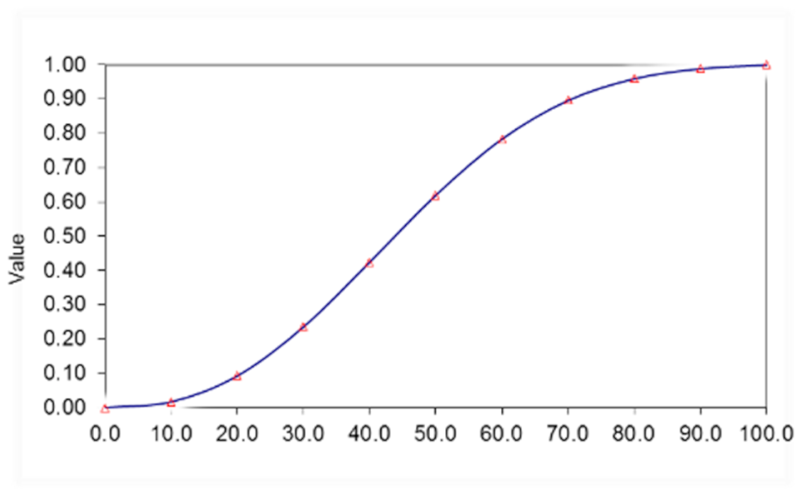 |
| Asphalt surface quality (70) | 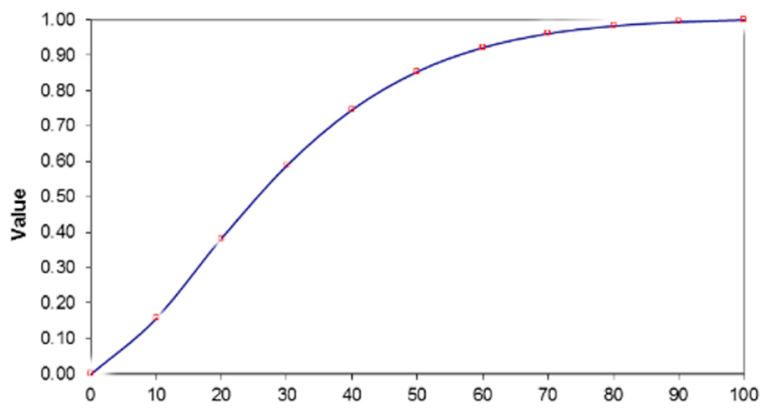 | ||
| Accessibility (20) | Compliance with regulations (100) | Adaptations in infrastructure for elderly and infirm persons (40) | 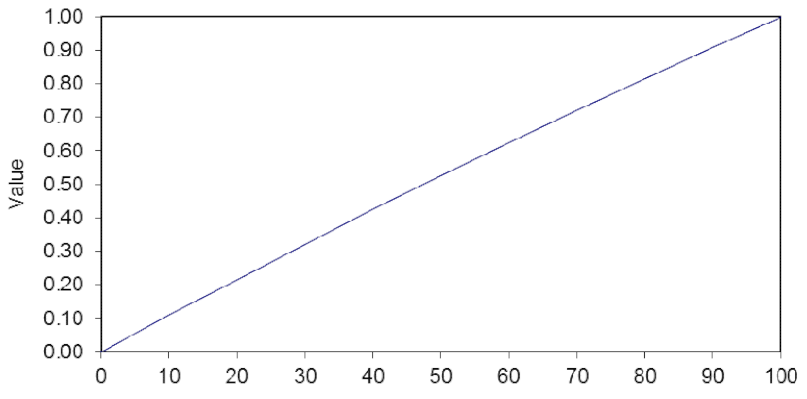 |
| Circulation areas (60) | 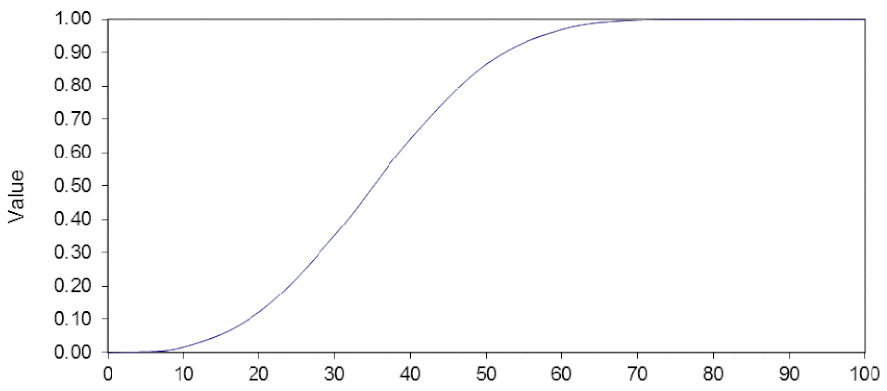 | ||
| Mobility (30) | Pedestrian (20) | Level service sidewalk (40) | 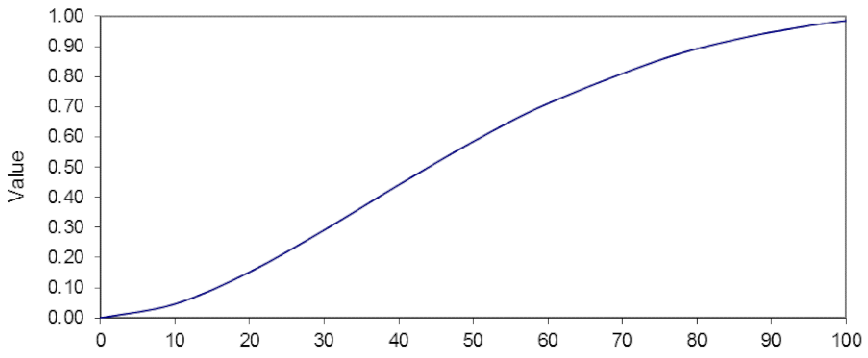 |
| Mobility quality (40) | 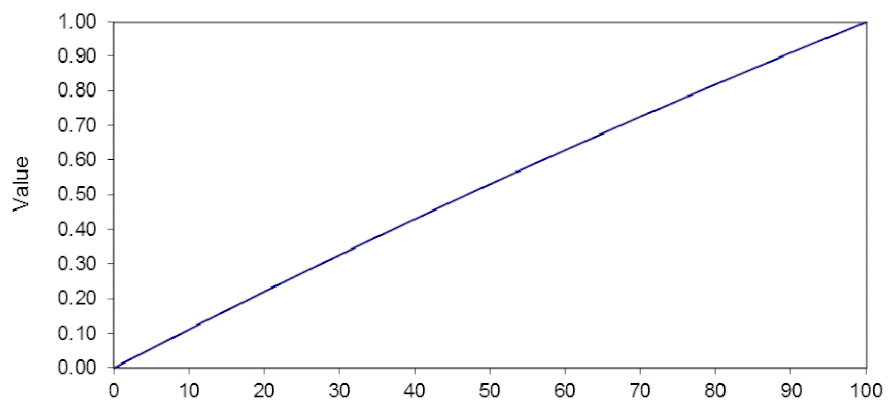 | ||
| Noise pollution (20) |  | ||
| Light vehicle (10) | Interferences on the street (100) | 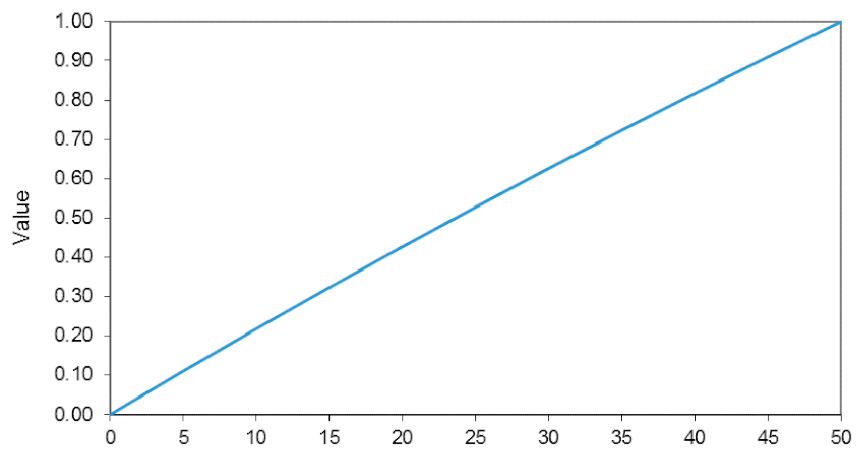 | |
| Cyclist (20) | Travel quality and safety (100) |  | |
| Public transportation (50) | Quality of infrastructure and signage (100) | 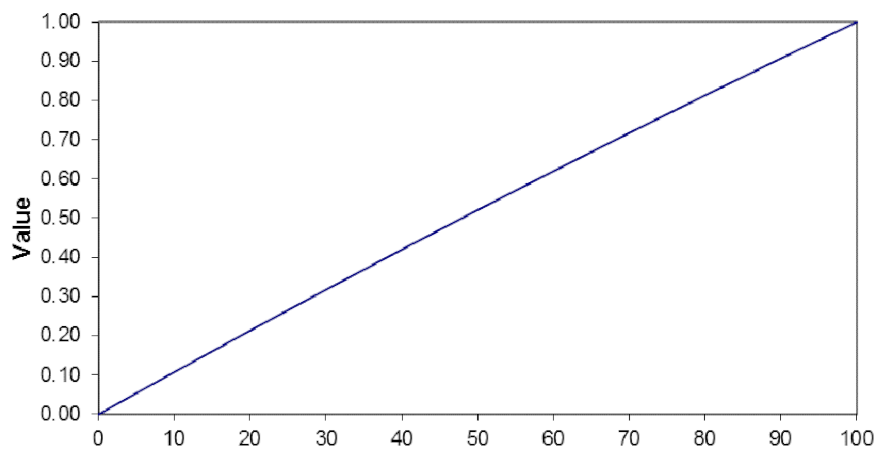 |
| Mobility Index | Urban Street (%) | |||||||||
|---|---|---|---|---|---|---|---|---|---|---|
| 1 | 2 | 3 | 4 | 5 | 6 | 7 | 8 | 9 | 10 | |
| 0.55 | 0.48 | 0.50 | 0.85 | 0.56 | 0.34 | 0.31 | 0.20 | 0.28 | 0.45 | |
| Urban Infrastructure | 50 | 42 | 50 | 98 | 44 | 32 | 14 | 26 | 20 | 42 |
| Accessibility | 70 | 60 | 50 | 70 | 60 | 70 | 50 | 10 | 50 | 50 |
| Mobility | 50 | 50 | 47 | 73 | 70 | 10 | 47 | 17 | 23 | 43 |
| Physical state of the element | 50 | 42 | 50 | 98 | 45 | 33 | 13 | 26 | 21 | 42 |
| Compliance with regulations | 72 | 62 | 51 | 70 | 62 | 72 | 51 | 10 | 51 | 51 |
| Pedestrian | 40 | 50 | 60 | 60 | 60 | 50 | 55 | 40 | 35 | 45 |
| Light vehicle | 30 | 60 | 60 | 60 | 60 | 10 | 80 | 30 | 30 | 10 |
| Cyclist | 74 | 40 | 25 | 100 | 90 | 0 | 16 | 25 | 15 | 90 |
| Public transport | 52 | 52 | 52 | 72 | 72 | 0 | 42 | 0 | 24 | 34 |
| Sidewalk quality | 78 | 52 | 78 | 96 | 62 | 24 | 9 | 0 | 33 | 52 |
| Asphalt Surface quality | 38 | 38 | 38 | 100 | 38 | 38 | 16 | 38 | 16 | 38 |
| Infrastructure adaptations | 52 | 26 | 0 | 26 | 26 | 52 | 0 | 26 | 0 | 0 |
| Area of circulation | 86 | 86 | 86 | 100 | 14 | 86 | 86 | 0 | 86 | 86 |
| Sidewalk service levels | 63 | 38 | 63 | 38 | 83 | 38 | 63 | 45 | 25 | 48 |
| Mobility quality | 86 | 92 | 21 | 92 | 92 | 92 | 92 | 86 | 72 | 86 |
| Noise pollution | 45 | 66 | 0 | 53 | 41 | 66 | 22 | 41 | 37 | 60 |
| Interferences | 32 | 63 | 63 | 63 | 63 | 11 | 82 | 32 | 32 | 11 |
| Quality of the journey and safety | 74 | 42 | 26 | 100 | 91 | 0 | 42 | 26 | 16 | 91 |
| Quality of infrastructure and signaling | 52 | 52 | 52 | 72 | 72 | 0 | 42 | 0 | 25 | 35 |
| Mobility Index | Urban Street (%) | ||||||
|---|---|---|---|---|---|---|---|
| 1 | 2 | 3 | 4 | 5 | 6 | 7 | |
| 0.25 | 0.21 | 0.13 | 0.62 | 0.28 | 0.21 | 0.26 | |
| Urban Infrastructure | 37 | 29 | 11 | 55 | 34 | 31 | 42 |
| Accessibility | 0 | 0 | 0 | 86 | 13 | 0 | 0 |
| Mobility | 24 | 22 | 24 | 57 | 30 | 18 | 16 |
| Physical state of the element | 37 | 24 | 11 | 55 | 34 | 31 | 42 |
| Compliance with regulations | 0 | 0 | 0 | 86 | 13 | 0 | 0 |
| Pedestrian | 49 | 42 | 54 | 64 | 57 | 61 | 47 |
| Light vehicle | 0 | 0 | 0 | 32 | 0 | 11 | 11 |
| Cyclist | 42 | 42 | 0 | 91 | 26 | 26 | 26 |
| Public transport | 11 | 11 | 26 | 45 | 26 | 0 | 0 |
| Sidewalk quality | 33 | 9 | 0 | 96 | 24 | 16 | 52 |
| Asphalt Surface quality | 38 | 38 | 16 | 38 | 38 | 38 | 38 |
| Infrastructure adaptations | 0 | 0 | 0 | 64 | 32 | 0 | 0 |
| Area of circulation | 0 | 0 | 0 | 100 | 0 | 0 | 0 |
| Sidewalk service levels | 59 | 5 | 59 | 59 | 86 | 86 | 59 |
| Mobility quality | 33 | 53 | 33 | 56 | 11 | 33 | 11 |
| Noise pollution | 60 | 95 | 85 | 90 | 90 | 66 | 94 |
| Interferences | 0 | 0 | 0 | 32 | 0 | 11 | 11 |
| Quality of the journey and safety | 42 | 42 | 0 | 91 | 26 | 26 | 26 |
| Quality of infrastructure and signaling | 11 | 11 | 26 | 45 | 26 | 0 | 0 |
| Mobility Index | Urban Street (%) | |||||||||
|---|---|---|---|---|---|---|---|---|---|---|
| 1 | 2 | 3 | 4 | 5 | 6 | 7 | 8 | 9 | 10 | |
| 0.73 | 0.80 | 0.31 | 0.45 | 0.78 | 0.52 | 0.45 | 0.48 | 0.74 | 0.54 | |
| Urban Infrastructure | 87 | 97 | 34 | 60 | 99 | 75 | 71 | 78 | 97 | 77 |
| Accessibility | 73 | 76 | 24 | 5 | 73 | 13 | 5 | 5 | 73 | 17 |
| Mobility | 49 | 53 | 31 | 47 | 47 | 37 | 29 | 28 | 38 | 38 |
| Physical state of the element | 87 | 97 | 34 | 60 | 99 | 75 | 71 | 78 | 97 | 77 |
| Compliance with regulations | 72 | 76 | 24 | 4 | 72 | 13 | 4 | 4 | 72 | 17 |
| Pedestrian | 87 | 76 | 76 | 52 | 87 | 73 | 76 | 80 | 55 | 79 |
| Light vehicle | 32 | 53 | 53 | 32 | 53 | 32 | 32 | 3 | 53 | 32 |
| Cyclist | 39 | 39 | 28 | 39 | 42 | 28 | 28 | 28 | 28 | 28 |
| Public transport | 42 | 49 | 11 | 52 | 32 | 28 | 11 | 6 | 32 | 28 |
| Sidewalk quality | 90 | 90 | 24 | 2 | 96 | 53 | 2 | 62 | 90 | 24 |
| Asphalt Surface quality | 85 | 100 | 38 | 85 | 100 | 85 | 100 | 85 | 100 | 100 |
| Infrastructure adaptations | 52 | 60 | 60 | 11 | 52 | 32 | 11 | 11 | 52 | 42 |
| Area of circulation | 86 | 86 | 0 | 0 | 86 | 0 | 0 | 0 | 86 | 0 |
| Sidewalk service levels | 100 | 100 | 100 | 58 | 100 | 100 | 100 | 100 | 58 | 100 |
| Mobility quality | 71 | 50 | 43 | 33 | 71 | 50 | 43 | 50 | 33 | 50 |
| Noise pollution | 95 | 80 | 95 | 80 | 92 | 63 | 96 | 100 | 91 | 95 |
| Interferences | 32 | 53 | 53 | 32 | 53 | 32 | 32 | 32 | 53 | 32 |
| Quality of the journey and safety | 39 | 39 | 28 | 39 | 42 | 28 | 28 | 28 | 28 | 28 |
| Quality of infrastructure and signaling | 42 | 49 | 11 | 52 | 32 | 28 | 11 | 6 | 32 | 28 |
Publisher’s Note: MDPI stays neutral with regard to jurisdictional claims in published maps and institutional affiliations. |
© 2021 by the authors. Licensee MDPI, Basel, Switzerland. This article is an open access article distributed under the terms and conditions of the Creative Commons Attribution (CC BY) license (http://creativecommons.org/licenses/by/4.0/).
Share and Cite
Villegas Flores, N.; Saldeño Madero, Y.; Torres Parra, C.A.; Fasolino, I.; Rondón Quintana, H.A. Multi-Criteria Approach for Prioritizing and Managing Public Investment in Urban Spaces. A Case Study in the Triple Frontier. Sustainability 2021, 13, 3345. https://doi.org/10.3390/su13063345
Villegas Flores N, Saldeño Madero Y, Torres Parra CA, Fasolino I, Rondón Quintana HA. Multi-Criteria Approach for Prioritizing and Managing Public Investment in Urban Spaces. A Case Study in the Triple Frontier. Sustainability. 2021; 13(6):3345. https://doi.org/10.3390/su13063345
Chicago/Turabian StyleVillegas Flores, Noé, Yelinca Saldeño Madero, Camilo Alberto Torres Parra, Isidoro Fasolino, and Hugo Alexander Rondón Quintana. 2021. "Multi-Criteria Approach for Prioritizing and Managing Public Investment in Urban Spaces. A Case Study in the Triple Frontier" Sustainability 13, no. 6: 3345. https://doi.org/10.3390/su13063345
APA StyleVillegas Flores, N., Saldeño Madero, Y., Torres Parra, C. A., Fasolino, I., & Rondón Quintana, H. A. (2021). Multi-Criteria Approach for Prioritizing and Managing Public Investment in Urban Spaces. A Case Study in the Triple Frontier. Sustainability, 13(6), 3345. https://doi.org/10.3390/su13063345






